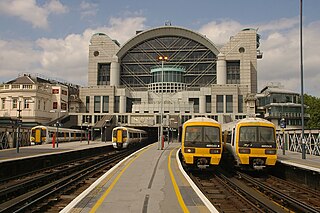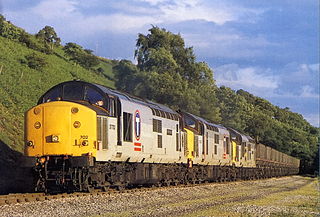
DB Cargo UK is a British rail freight company owned by Deutsche Bahn and headquartered in Doncaster, England.

Transrail was a trainload rail freight operator based in St Blazey, England, UK with a large operating area including Scotland, Wales and the west of England. It was formed in 1994 from part of British Rail's Trainload Freight division, as part of the privatisation of British Rail.

The British Rail Class 37 is a diesel–electric locomotive. Also known as the English Electric Type 3, the class was ordered as part of the British Rail modernisation plan. They were numbered in two series, D6600–D6608 and D6700–D6999.

The British Rail Class 92 is a dual-voltage electric locomotive, which can run on 25 kV AC from overhead wires or 750 V DC from a third rail. It was designed specifically to operate services through the Channel Tunnel between Great Britain and France. Eurotunnel indicates the Class 92 locomotive as the reference for other locomotives which railway undertakings might want to get certified for usage in the Channel tunnel.

Didcot Parkway is a railway station serving Didcot, a town in Oxfordshire, England. The station was opened as Didcot on 12 June 1844 and was renamed Didcot Parkway on 29 July 1985 by British Rail, to reflect its role as a park and ride railhead. It is 53 miles 10 chains down the line from London Paddington and is situated between Cholsey to the east and Swindon to the west.

The South Eastern Main Line is a major long-distance railway route in South East England, UK, one of the three main routes crossing the county of Kent, going via Sevenoaks, Tonbridge, Ashford and Folkestone to Dover. The other routes are the Chatham Main Line which runs along the north Kent coast to Ramsgate or Dover via Chatham and High Speed 1 which runs through the centre of Kent to the coast at Folkestone where it joins the Channel Tunnel.

Tinsley was a railway marshalling yard near Tinsley in Sheffield, England, used to separate railway wagons from incoming trains and add them to new trains. It was sited immediately west of the M1 motorway, about one mile north of the Catcliffe junction. It was opened in 1965, as a part of a major plan to rationalise all aspects of the rail services in the Sheffield area; it closed in stages from 1985, with the run-down of rail freight in Britain. It was also the site of Tinsley Traction Maintenance Depot (TMD), which was closed in 1998; at its peak, 200 locomotives were allocated to this depot.

St Blazey engine shed is located in Par, Cornwall, United Kingdom, although it is named after the adjacent village of St Blazey. It was built in 1874 as the headquarters of the Cornwall Minerals Railway but for many years was a depot of the Great Western Railway. The current depot operator is DB Cargo and the depot TOPS code is BZ.
Speedlink was a wagonload freight service that used air-braked wagons and was operated by British Rail from 1977 to 1991.
In rail freight transportation the terms wagonload or wagonload freight refer to trains made of single wagon consignments of freight. In the US and Canada the term carload refers to a single car of any kind, and manifest train refers to trains made of diverse cars of freight.

The railway network in Great Britain has been used to transport goods of various types and in varying volumes since the early 19th century. Network Rail, which owns and maintains the network, aims to increase the amount of goods carried by rail. In 2015–16 Britain's railways moved 17.8 billion net tonne kilometres, a 20% fall compared to 2014–15. Coal accounted for 13.1% of goods transport in Britain, down considerably from previous years. There are no goods transported by railway in Northern Ireland.

The second use of the TOPS classification Class 21 for locomotives used on the British railway network came through the use of a number of related diesel-hydraulic and diesel-electric locomotives procured following the opening of the Channel Tunnel. The total of 16 locomotives were obtained by two separate operators, with some used for freight, and others to propel service trains and as "Thunderbird" locomotives.

The Dover–Dunkerque train ferry was one of two regular rail freight train ferries that operated between the United Kingdom and Europe. The route connected the English port of Dover, with the French port of Dunkerque. After rationalisation of other Anglo-European train ferries, the Dover to Dunkerque sailing was the last to survive, though it ended its days on freight carryings only after the Night Ferry passenger service ended in 1980. The last Dover to Dunkerque wagon-freight ferry service became redundant upon the opening of the Channel Tunnel when freight was carried directly through the Channel Tunnel.

Healey Mills Marshalling Yard was a railway marshalling yard located in the village of Healey, south west of Ossett in West Yorkshire, England. The yard was opened in 1963 and replaced several smaller yards in the area. It was part of the British Transport Commission's Modernisation plan, and so was equipped with a hump to enable the efficient shunting and re-ordering of goods wagons. The yard lost its main reason for existence through the 1970s and 1980s when more trains on the British Rail system became block trains where their wagons required less, or more commonly, no shunting.

Stourton Freightliner Terminal, is a railfreight intermodal transport hub located in Stourton, Leeds, England. It is operated by the Freightliner Group, and has services arriving and departing for ports in Felixstowe, Southampton and Tilbury in the south of England. Stourton serves as a dedicated collection and delivery point for containers across Yorkshire, with a minor sub-service to Teesport in Middlesbrough by rail.

Intermodal railfreight in Great Britain is a way of transporting containers between ports, inland ports and terminals in England, Scotland and Wales, by using rail to do so. Initially started by British Rail in the 1960s, the use of containers that could be swapped between different modes of transport goes back to the days of the London, Midland & Scottish Railway.

Basford Hall Yard is a railway marshalling yard near the town of Crewe, Cheshire, England. The yard, which is 0.93 miles (1.5 km) south of Crewe railway station, was opened in 1901 by the London and North Western Railway (LNWR). Initially used to marshal trains, the site now acts as a hub mainly for Freightliner intermodal trains, but also houses departmental sidings as used by Freightliner Heavy Haul, and other operators. For a period in the 1930s, Basford Hall was the busiest marshalling yard in Europe, handling between 28,000 and 47,000 wagons every week.

Dringhouses Yard was a railway freight marshalling yard on the East Coast Main Line (ECML), south of York railway station in England. The yard was built during the First World War to help with the increase in traffic caused by the support to the British war effort. The yard was modernised in the 1960s, being fitted with a hump (knuckle), to ease shunting operations. It was closed to all traffic in 1987 after the loss of local railfreight traffic around York.

Washwood Heath Yard was a marshalling yard, and later sidings, to the east of Birmingham, in the West Midlands, England. The site was first host to sidings in the late 1870s, which were upgraded to a hump marshalling yard by 1900 which survived until the early 1980s. Thereafter, the site was flat shunted, but moreover used as a layover yard, rather than used for the transfer or interchange of wagons between trains. It was run-down and closed in late 2008 due to the loss of most of the automotive traffic that it was latterly used for. The lines were removed by 2020.
Perth New Yard is a former railway marshalling yard in the city of Perth, Scotland. The yard was built in the early 1960s to gather traffic from around the Perth area and goods wagons from the lines radiating from Perth. It was latterly used as an engineering and wagon storage depot until it was finally closed in 2008. Though abandoned, the site is registered with Canmore, the Historic Environment Scotland.

















